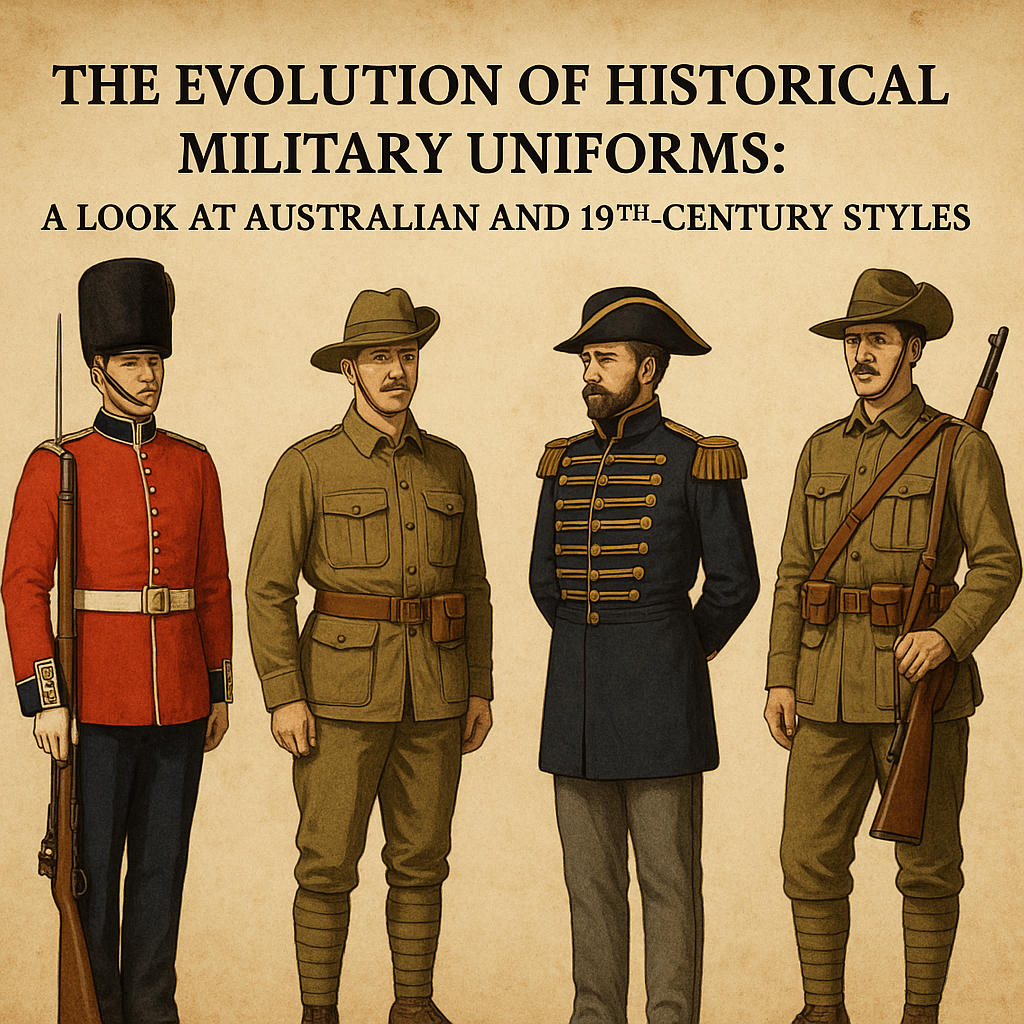
The Evolution of Historical Military Uniforms: A Look at Australian and 19th-Century Styles
Published on May 15, 2025
The Evolution of Historical Military Uniforms: From Colonial Times to the Trenches
Uniforms have always played a powerful role in warfare—not only as protective garments but also as visual representations of authority, nationalism, and military tradition. From the bold colors of the 19th-century military uniforms to the practical yet iconic design of the WW1 Australian uniform, military attire has evolved with each era’s unique demands.
At Paddelaters.com, we specialize in high-quality replicas of historical military uniforms that celebrate the craftsmanship, symbolism, and utility of military dress through the ages. This article provides a comprehensive view of how uniforms developed, especially in the Australian context, offering an educational journey through fabric, function, and history.
19th Century Military Uniforms: The Roots of Military Elegance
The 1800s were characterized by grandeur and regimental pride. Military uniforms from this period were anything but subtle. They were designed to impress, intimidate, and inspire.
Distinctive Features of 19th-Century Military Uniforms:
- Bright Colors: Red for British regiments, deep navy for French forces, and other bold hues signaled national pride and identification in the field.
- Decorative Braids & Epaulettes: These emphasized rank and distinguished officers from foot soldiers.
- Stiff Tunics & Headgear: Uniforms were more rigid, built to last through parades, battlefields, and colonial postings.
- Ornamental Functionality: While not always the most practical, 19th-century uniforms were about visual order, uniformity, and tradition.
Australian colonial forces, prior to the Federation in 1901, mirrored British uniform design but adapted slightly for climate and practicality. These early uniforms laid the groundwork for the nation’s unique military identity.
Explore more about these at our Military Uniforms of the 19th Century page.
Australia’s Military Identity and the Birth of the WW1 Uniform
Australia’s entry into World War I marked a significant turning point—not only in terms of international engagement but also in solidifying a uniquely Australian military identity. The WW1 Australian uniform became a globally recognized symbol of courage and mateship.
Key Characteristics of the WW1 Australian Uniform:
- The Slouch Hat: Unique to the Australian army, this wide-brimmed hat became a national icon, worn with one side turned up and often featuring the Rising Sun badge.
- Khaki Wool Tunics and Breeches: Designed for both camouflage and durability, these garments marked a shift from ornamental to functional.
- Webbing and Equipment: Soldiers carried everything they needed—rifle ammunition, water bottles, and personal items—on their backs.
- Puttees and Leather Boots: Puttees were woolen strips wrapped around the lower leg for support and protection in muddy conditions.
These uniforms had to withstand the brutal realities of trench warfare while still maintaining a sense of unity and identity. Today, they remain one of the most honored representations of Australian bravery.
You can view authentic reproductions of these on our WW1 Australian Uniform page.
Symbolism and Purpose Behind Military Uniforms
Uniforms are more than attire—they are carriers of meaning.
1. Identity and Allegiance
Uniforms make it easy to identify which side a soldier belongs to. This was crucial on chaotic battlefields, where friendly fire was a constant threat.
2. Camaraderie and Unity
Uniforms break down social barriers within military units, forging bonds based on common experience and shared identity.
3. Hierarchy and Role
Badges, stripes, and insignia help communicate rank and function—from generals to privates, medics to engineers.
4. Function and Protection
While early military uniforms prioritized appearance, modern iterations—like the WW1 Australian uniform—were built for utility and survival in harsh conditions.
Australian Military Uniforms: Pride, Heritage, and Innovation
Australia’s military dress has undergone significant evolution, from its early colonial uniforms influenced by British fashion to the globally respected ANZAC uniforms of World War I.
Over time, uniform changes reflected:
- Australia’s climate (lighter fabrics, wide-brimmed hats)
- Indigenous contributions and regimental diversity
- Combat demands of modern warfare
- A national identity that stood apart from Britain while honoring shared heritage
Today, vintage Australian military uniforms are collector’s treasures. They serve as educational tools, cultural artifacts, and deeply personal heirlooms.
The Role of Historical Uniforms Today
Why do historical military uniforms continue to capture attention?
1. Historical Reenactments
Enthusiasts across Australia and globally participate in meticulously accurate reenactments. Wearing proper uniforms adds realism and educates audiences.
2. Museum Displays & Education
Museums and schools use historical uniforms to teach military history, design evolution, and national identity.
3. Personal Tribute
Descendants of WW1 soldiers uniform or 19th-century service members wear replica uniforms to honor their family’s legacy.
4. Collecting & Preservation
Collectors value authenticity, condition, and detail. Uniforms are preserved like artwork, passed down across generations.
At Paddelaters.com, we provide these collectors and educators with access to high-quality replicas that respect historical detail.
Why Authenticity Matters in Reproducing Historical Uniforms
Accurate reproduction involves more than just copying the look—it’s about understanding the spirit of the uniform.
Our Approach at Paddelaters:
- Authentic Materials: Wool, leather, and metalwork modeled after original patterns.
- Exact Patterns: Tunics, hats, and insignia are constructed using historically verified templates.
- Research-Driven Design: We consult archives, historians, and military records to get every button right.
Our customers include reenactors, museum curators, war history students, and anyone passionate about historical accuracy.
Conclusion: Wear the Legacy
The journey of historical military uniforms is a story of evolution—from the ornate splendor of 19th-century ranks to the rugged practicality of the WW1 Australian uniform. These garments were forged in battle, built on tradition, and worn by men who shaped history.
Understanding their context deepens our respect for the soldiers and the societies they represented. Whether you're a collector, historian, reenactor, or simply curious about the past, wearing or displaying a historical military uniform is a meaningful way to connect with legacy.
At Paddelaters.com, we honor that connection by offering museum-grade replicas of uniforms that mattered. Step into the past and wear the story.
